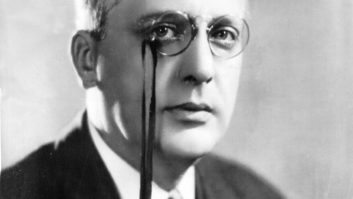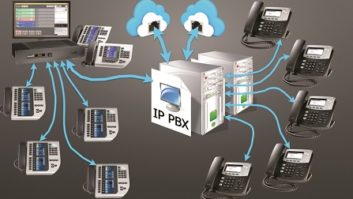Lawrence Behr, CEO of LBA Group Inc., spoke recently at an FCC Broadband Access Acceleration Conference. Radio World invited him to flesh out the comments he made at the task force meeting.
AM radio towers stand ready — literally — to help government and wireless industry leaders broaden access to digital networks by hosting wireless antennas. Yet relatively few AM towers have the antennas colocated on them. Why?
The reason is not technological. Rather, simple distrust and misunderstanding exist across the digital and AM divide.

AM and wireless leaders don’t fully understand each other’s technology; not only are they 1,000 megahertz apart, they are a hundred years apart. In addition, the availability of some towers for colocation is not widely known.
Radio station owners and operators should lead the way in clearing away these barriers, first by recognizing the benefits of linking up with the wireless industry.
The benefits can be summarized in two words: new profits.
You are their infrastructure
Colocating wireless antennas on a tower can swell an AM station’s revenue stream.
AM’s estimated 10,000 towers are existing infrastructure for broadband expansion across the U.S. Many of the towers are positioned in underserved rural areas or desirable urban broadband coverage areas.
Yet radio station operators traditionally have rejected out of hand any thought of cooperating with a wireless carrier, fearing a digital antenna would interfere with AM station signals. For this reason, the Federal Communications Commission continues to police the wireless realm to ensure that digital hardware doesn’t disrupt AM broadcast patterns.
For their part, wireless carriers have gone out of their way to avoid AM towers and signals because of these interference problems, as well as presumed safety and grounding issues.
Furthermore, from an engineering standpoint, placing wireless and AM facilities in close proximity meant coordinating with the FCC, which generally lengthened and aggravated the process. So carriers have resorted to building their own outlying towers — with attendant zoning hearing hassles.
Technologies now are available to overcome these problems and efficiently integrate wireless and AM systems at reasonable costs.
Real money
Numerous AM station owners, such as Sotirios Angelatos in Florida and Bob Vinikoor in New England, are proof that colocation works.
Angelatos and Vinikoor are earning $1,600 to $2,400 every month from each wireless antenna attached to their respective broadcast towers.
Vinikoor owns five radio stations in Vermont and New Hampshire and has 15 wireless antennas attached to his towers.
“If anyone has reservations about allowing cellular companies to colocate on their towers, I would highly recommend that they reconsider that decision,” he said. “Once construction is done, it’s pretty much seamless and the cellular companies operate in the background.”
In February, a station in Hawaii became the latest AM facility to share its tower using an LBA Group colocation system. These and other station owners are beneficiaries of engineering that overcame the intrinsically incompatible properties of AM and wireless.
In the AM band, the tower itself is the radiating element, whereas wireless antennas and coaxial cables are self-contained systems that merely attach to support structures. The two systems now have been engineered to co-exist and to do so in synergism.
One technological approach to AM colocation is a proprietary LBA system called CoLoSite. The system is based on patented hardware by LBA Technology Inc. with engineering and integration systems implemented by Lawrence Behr Associates Inc.
With CoLoSite, colocation is practical for both single-tower and multiple-tower AM antenna systems. Using the system, wireless antenna and coaxial cable installations have virtually no effect on host AM towers and the AM signal has no effect on the wireless antenna.

Colocation allows wireless antenna and AM towers to function together. Pictured is a Colocoil RF Isocoupler, which permits addition of antennas and coaxial cables.
Moreover, antennas and transmission lines can be added without the use of additional isolation devices. This means a tower owner can lease additional space to other wireless carriers, limited only by a tower’s structural capacity.
On non-directional towers, an isolation system called CoLoPole typically is used. CoLoPole directly grounds an AM tower. Wireless antennas and transmission lines are mounted and bonded directly onto a structure. The system benefits the AM station with improved efficiency, “air sound” and lightning protection, thus enhancing the colocation experience for the station.
Directional stations use multiple towers to form an FCC-licensed radiation pattern crucial to protecting other stations from interference. LBA developed an isolation system called CoLoCoil that effectively prevents wireless transmission lines from interfering with the operating parameters of the directional AM towers.
List yourself
While all AM stations theoretically may be used for wireless colocations, practical factors render some facilities economically or technically unattractive for colocation. Therefore, planning for any AM colocation begins with a facility analysis.
Where multiple towers exist, choosing the optimum one is critical because a wrong choice can pad project costs. AM operations can, of course, be complex, with different towers or even different sites being used for day or night transmissions and at varying power levels. Yet all the complexity yields to colocation engineering.
Many AM radio station owners haven’t received colocation offers for a good reason: Wireless carries aren’t aware of their towers. The towers are hiding there in plain sight.
To get these AM towers into play, Vinikoor recommends that owners have them listed — for free — by the Federal Aviation Administration so wireless companies can know of their existence. (Applications for FAA clearance, which get a tower into its database, can be filed online.)
In short, broadening broadband access across the United States continues to be a government priority in 2011. AM stations have valuable assets to help facilitate this expansion. It is to the station owners’ financial advantage to team up with carriers.
Because there is no operating downside — thanks to proven engineered solutions — the only remaining question for a station owner is, why are you not doing so?
LBA Group Inc. supports infrastructure assets of the wireless telecommunications industry.








